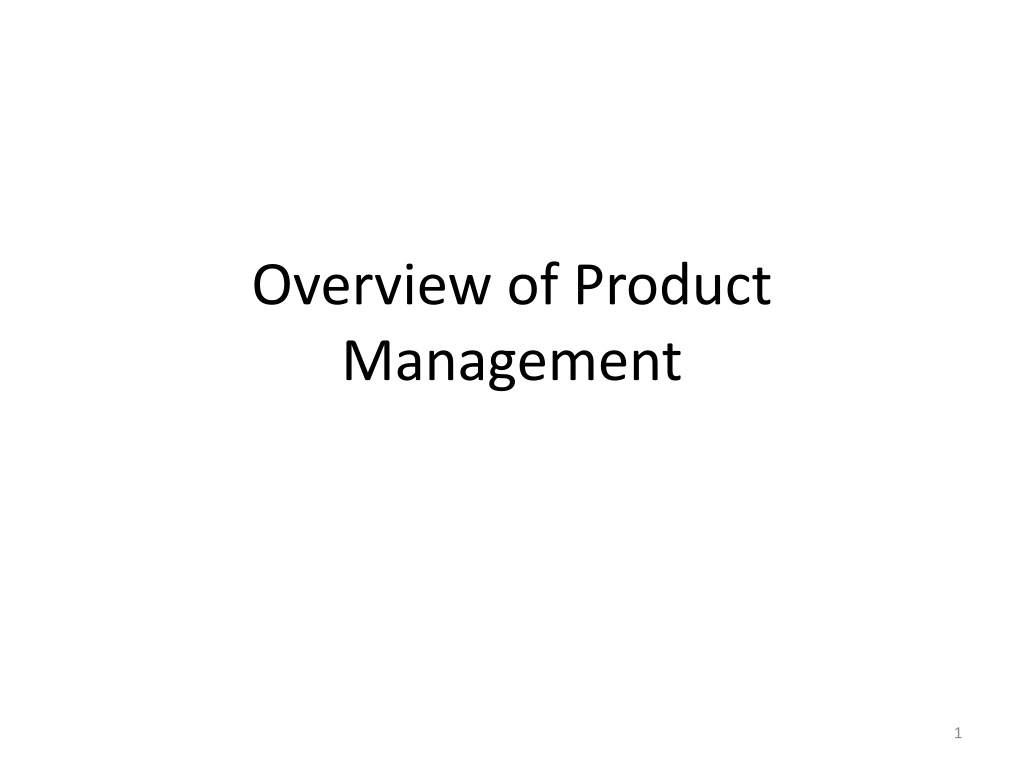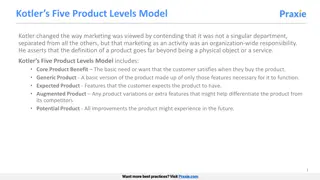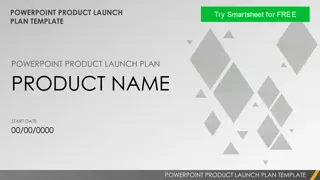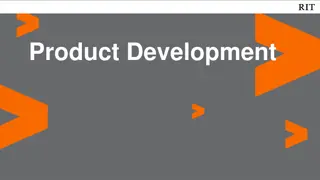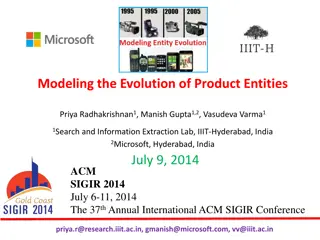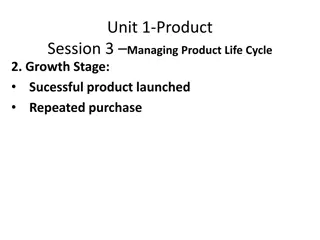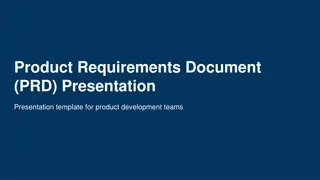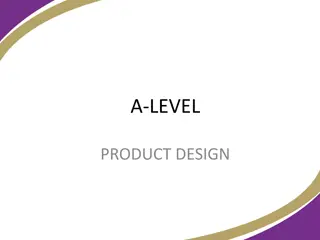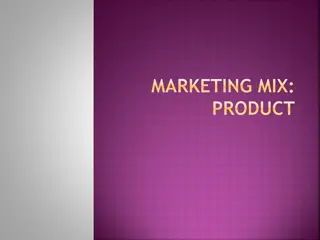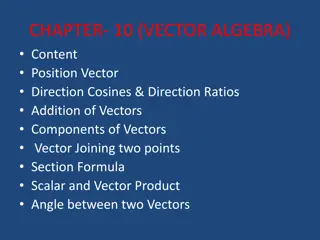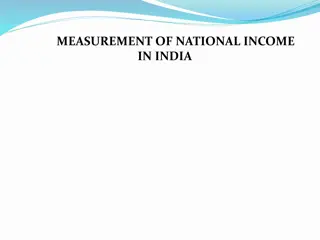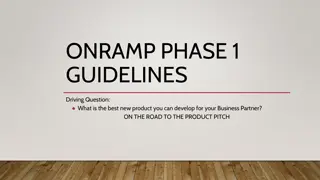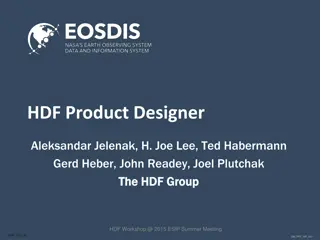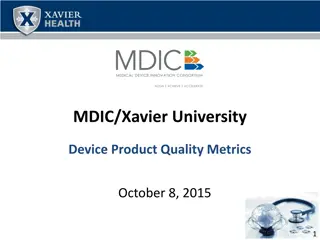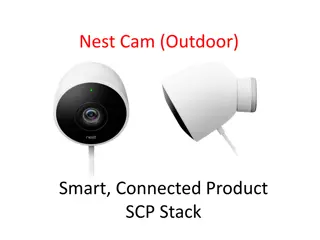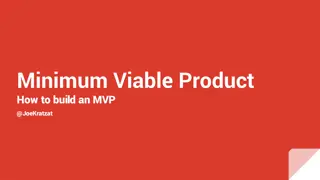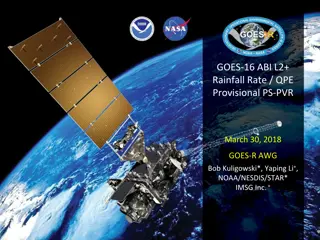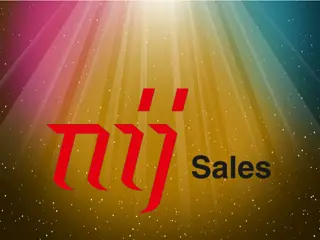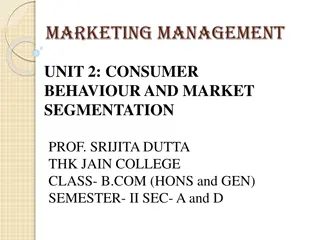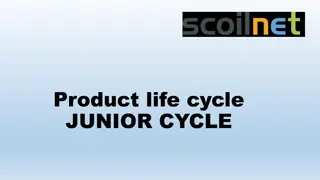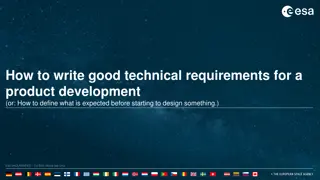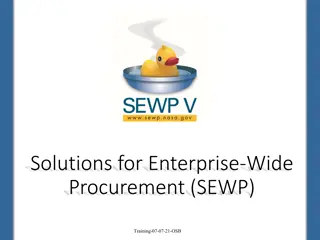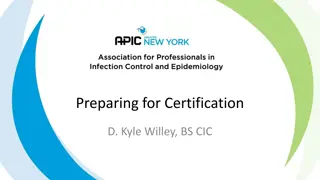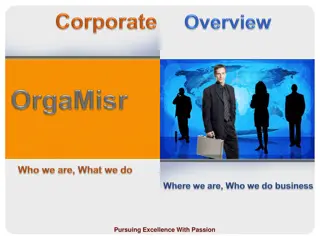Comprehensive Guide to Product Management Strategies
This comprehensive guide covers various aspects of product management, including product classifications, product decisions, new product development strategies, and steps in the product development process. Explore the importance of defining new products, acquiring products, and overcoming challenges in innovation to achieve success in the market.
Download Presentation

Please find below an Image/Link to download the presentation.
The content on the website is provided AS IS for your information and personal use only. It may not be sold, licensed, or shared on other websites without obtaining consent from the author. Download presentation by click this link. If you encounter any issues during the download, it is possible that the publisher has removed the file from their server.
E N D
Presentation Transcript
Overview of Product Management 1
Product and Major Classifications What is a Product? Tangible goods Vs Service Levels of Product and Services Core Product Formal Product Augmented Product Product and Service Classifications Consumer Products Industrial products 2
Product Decisions Product Line Decisions A product line is a group of products that are closely related Product line length is the number of items in the product line. The line can be lengthened by:- Product line stretching Product-line filling 3
Product Decisions Product Mix Decisions A product mix (or product assortment) consists of all the product lines and items that a particular seller offers for sale. A company s product mix can be described in terms of the following through which the company can increase its business:- Width Length Depth Consistency 4
New Product Development Strategy Defining a New Product. A product that has been introduced in the market place for the very first time. A product that is new to the company. The product can be a radical innovation which is entirely new in its category or a minor/ major upgrades to the existing products in terms of features/ packaging/ marketing. Eg:- Ipad, Ipod Classic, Ipad2, Ipod Nano, Crocin Advance etc. Why develop new products? 5
New Product Development Strategy Two ways to obtain new products by the organization:- Acquisition Eg:- Microsoft acquisition of Nokia Facebook acquisition of Instagram & WhatsApp New Product Development Eg:- Ipad, Ipod, 3D TV, IBM Mainframes, Sewing Machines, Microsoft Windows Operating System. Innovation can be very risky. Why? How to overcome difficulties and pitfalls is to identify successful new products? 6
New Product Development Strategy Various Steps in New Product Development Process Idea Generation Idea Screening Concept Development and Testing Marketing Strategy Development Business Analysis Product Development Test Marketing Commercialization 7
New Product Development Strategy Idea Generation (Stage 1) Systematic search for new product ideas Idea Vs Commercialization Sources for new product ideas:- Internal sources, customers, competitors, distributors, suppliers and others in the distribution chain Idea Screening (Stage 2) One of the most important step in the overall strategy companies must proceed only with product ideas that will turn into profitable products 8
New Product Development Strategy Concept Development and Testing (Stage 3) Concepts may take on several forms Identifying attractiveness of each concept to consumer Testing the concepts with a group of target consumers New ways to make product concepts more real to concept-test subjects Caselet: DaimlerChrysler's 9
New Product Development Strategy Marketing Strategy Development (Stage 4) Designing an initial marketing strategy A marketing strategy statement should be produced which consists of three parts:- Target market product's planned price, distribution, and marketing budget for the first year planned long-run sales, profit goals, and marketing mix strategy 10
New Product Development Strategy Business Analysis (Stage 5) Review of the sales, costs, and profit projections and the break even point for a new product Ensuring the projections are in line with the company objectives Survey for the market opinion To estimate sales, the company might look at the sales history of similar products and conduct surveys of market opinion 11
New Product Development Strategy Product Development (Stage 6) Developing the product concept into a physical product Investment is paramount at this stage This stage can be time consuming and multiple versions of the product concept could be developed Prototypes must have the required functional features and convey the intended psychological characteristics Caselet: Gillette 12
New Product Development Strategy Test Marketing (Stage 7) Product and marketing program are introduced into more realistic marketing settings Objective:- To test the product itself in real markets The effort in the stage varies with each new product Costs can be high during this stage for the company Approaches used by consumer product companies:- Standard test markets Controlled test markets Simulated test markets 13
New Product Development Strategy Standard Test market Identification of Test Cities conducting a full marketing campaign Drawbacks:- Costs and lengthy period Eg:- Clorox vs P&G Controlled test markets uses controlled panels of stores that have agreed to carry new products for a fee. Less costly than the earlier procedure Takes less time period than standard test markets 14
New Product Development Strategy Simulated Test market Less expensive and requires short time period simulated test markets are as accurate or reliable as larger, real-world tests. Still, simulated test markets are used widely, often as "pretest" markets Example: Mistake by McDonalds: McLean Deluxe 15
New Product Development Strategy Commercialization (Stage 8) This step is introducing a new product into the market Full scale implementation promotional strategies Decisions related to timing and place for the launch of products is decided and implemented. Launch in the global markets could be done in the initial launch or in a phased approach. E.g.:- Most of the foreign players introduce new mobile phones in developed countries and then later on launch them in developing countries. of advertising and 16
Consumer Adoption Process Adoption is defined as the decision by an individual to become a regular user of the product Adoption Process was described by Bourne in 1959 This process is a type of decision making and occurs over a period of time. It is during this adoption process the consumer decides to become a new customer or not. The stages in the consumer adoption process become the set of rules for the consumer at the beginning of new product. There are 5 stages in the consumer adoption process 17
Consumer Adoption Process Stages in the Adoption Process Awareness (Stage 1) Trial (Stage 4) Interest (Stage 2) Evaluation (Stage 3) Adoption (Stage 5) Different Adopter Categories Innovators The late majority Laggards Early adopters The early majority 18
Consumer Adoption Process Influence of Product Characteristics on Rate of Adoption Superiority (Innovation s relative advantage ) Values and Experience (Innovation s compatibility ) Ease of use (Innovation s complexity ) Limited basis trial (Innovation s divisibility ) Results being observed or described to others (Innovation s communicability ) Other factors/ characteristics such as costs, risk, uncertainty, social approval, customs and behaviour may affect the rate of adoption. 19
Product Life Cycle and Strategies Each product seems to go through a life cycle Two major challenges of PLC Problem of new-product development Problem of product life cycle strategies The product life-cycle (PLC) is the course of a product s sales and profits over its lifetime The PLC has become one of the central topic to Marketing and is utilized by many firms as a part of their forecasting process. 20
Product Life Cycle and Strategies Product Life Cycle involves five distinct stages The product development Stage The introduction stage The growth stage The maturity stage The decline stage 21
Product Life Cycle and Strategies The product development Stage Starts with a a new-product idea sales are zero company s investment costs mount 22
Product Life Cycle and Strategies The Introduction Stage Product is new and available for purchase Profits are negative or low Lower number of sales (with exceptions, eg: Apple products) High distribution costs Prices tends to be high (Again depends on the pricing strategy of the company) Higher Promotion & Advertising costs (to improve awareness level) 23
Product Life Cycle and Strategies The Introduction Stage Usually few competitors More focus on buyers (Early adopters) Low market size (Until the awareness level improve) High investment costs Market Growth Rate will be highest (over a course of time) Company can have the 1st mover advantage if the strategy is executed properly 24
Product Life Cycle and Strategies The Growth Stage In this stage product s sales start climbing quickly Word of Mouth, advertising and promotional strategies result in increased sales at this stage New competitors may enter the market place Entry of paratroopers with same or enhanced features Market expansion takes place Competition may result in a price war Advertising and promotion budget increases 25
Product Life Cycle and Strategies The Growth Stage Profits will increase, due to higher sales. Firm would trade off between high market share and high current profit Growth rate would be high At this stage the company may want their current subscribers to purchase the new product E.g.:- Amazon promoting Kindle Paper white Apple exchanges iPhone 4/4s for iPhone 5 26
Product Life Cycle and Strategies The Maturity Stage Sales growth slows or levels off Hunt for new users and segments Introduction of loyalty programs to retain existing customers Reposition of the brand to appeal a larger segment E.g:- Repositioning strategy by Moov Product modification may happen Marketing mix modifications to sustain growth Market players consolidation 27
Product Life Cycle and Strategies The Maturity Stage No. of competitors remain stable Market growth rate will be low Profits start to decrease or remain stagnant every quarter Market size would be largest Investment would remain stable Continued reduction in costs of product due to economies of scale and improvement in production mechanisms over time 28
Product Life Cycle and Strategies The Decline Stage Product sales and profit figures decline Market share would also decline Companies need to pay more attention to their aging products Carrying the product may impact the company Companies look towards other manufacturing options to lower the cost or will be willing to exit the market place. 29
Product Life Cycle and Strategies The Decline Stage Management may decide to maintain its brand without change in the hope that competitors will leave the industry Management may decide to reposition or reformulate the brand. Eg:- Frito-Lay s Cracker Jack brand 30
Product Life Cycle and Strategies Does PLC curve remains same for all the products ? Not all products follow the S-shaped PLC The PLC can describe a product class, a product form, or a brand The PLC can also be applied to styles, fashions, and fads 31
Product Life Cycle and Strategies Difficulties with PLC Trouble identifying which stage of the PLC the product is in Difficult to forecast the sales level of the PLC stage, the length of each stage, and the shape of the PLC curve PLC concept to develop marketing strategy can also be difficult because strategy is both a cause and a result of the product s life cycle 32
Case Study Red Bull: Waking a New Market 33
Branding Introduction:- Branding started to develop and came to the picture in USA around early 20th century Brand was a guarantee of homogeneity and a signal of product quality Definition of Brand Aaker (1991), Keller (1998) Kotler (1994) & Lovelock (1999) defines brand as Distinguishing name and/or symbol intended to identify and differentiate . 34
Branding Definition of Brand Peter Doyle of Warwick University has given a comprehensive definition: A name, symbol, design, or some combination which identifies the product of a particular organization as having a substantial, differentiated advantage Development Of Branding Brands can also reduce the risk consumers face Consumerisation increases the focus changes from the primitive selling to the advanced concept of brand 35
Branding Development Of Branding Peter Doyle has classified this development of brand management in six eras namely:- Stage 1: Unbranded Goods Stage 2: Brand As Reference Or Awareness Stage 3: Brand As Bundle Of Ideas, Thoughts And Images Or Personality Stage 4: Brand As Icon Or An Identity Stage 5: Brand As A Position Stage 6: Brand as Policy 36
Branding Stage 1: Unbranded Goods Goods are treated as commodities Goods are not branded Demand is more, supply is less Rarely seen in developed economies Stage 2: Brand As Reference Or Awareness competitive pressures stimulate producers to differentiate their goods Changes in physical product attributes 37
Branding Stage 3: Brand As Bundle Of Ideas, Thoughts And Images Or Personality Differentiation becomes exceedingly difficult marketers begin to give their brands personalities value of the brand becomes self-expression Stage 4: Brand As Icon Or An Identity brand is "owned by consumers Consumers use brands it to create their self-identity 38
Branding Stage 5: Brand As A Position This stage marks the change to modern marketing Brand has a complex identity and has complex interaction with the consumer Stage 6: Brand as Policy Few companies to date have entered this stage Distinguished by an alignment of company with Ethical, Social And Political Causes 39
Branding From Products to Brands Lewis has suggested that a product becomes a brand through a process of formalization. Formalization creates between the product and customer. Involves conscious effort by the company to categorically detail out rational & emotional features of a brand Brand Equity is value the brand generates to a product. This value effort is the output of the entire branding effort emotional interphase Case Studies: a) Dr. Batra s Postive Health Clinic Ltd b) Navratna Oil 40
Branding Build Strong Brands Brands as the major enduring asset of a company The brand is more valuable than the totality of all these assets Brands are more than just names and symbols Brands reside in the minds of consumers A powerful brand has high brand equity Brand valuation is the process of estimating the total financial value of a brand Apple is $98 billion, Coca-Cola is $79 billion, Microsoft is $59 billion, and IBM is $78 billion (Interband.com, 2013) 41
Branding Build Strong Brands Branding poses challenging decisions to the marketer major brand strategy decisions involve brand positioning, brand name selection, brand sponsorship, and brand development 42
Branding Brand Positioning Defined as the Distinct Space a Brand occupies in the customers mind. This can be done at any of three levels: Product attributes. Name association with a desirable benefit. Positioned on beliefs and values A brand can be better positioned by associating its name with a desirable benefit. Volvo (safety), Hallmark (caring), Harley- Davidson (adventure) 43
Branding Brand Name Selection finding the best brand name is a difficult task. Begins with a careful review of the following:- product and its benefits, the target market and proposed marketing strategies Desirable qualities for a brand name include:- Name suggesting the product's benefits and qualities. E.g:- Ujala, Hajmola . Easy to pronounce, recognize, and remember Examples: Tide, Crest, Lux, Bata, Airel etc. should be distinctive, extendable and easily transferable into foreign languages. Eg: cinthol, Amazon, Oracle 44
Branding Brand Sponsorship A manufacturer has four sponsorship options:- Manufacture s Brands, Private Brands, Licensing andCo-Branding Increasing number of retailers and wholesalers have created their own private brands Eg: Sears, Walmart and Future group Private brands can be hard to establish and costly to stock and promote. Private brands generally have higher profit margins. 45
Branding Licensing Creating a brand name is time consuming Some companies license names or symbols previously created by other manufacturers, names of well-known celebrities, or characters from popular movies and books Apparel and accessories sellers pay large royalties to adorn their products Almost half of all retail toy sales come from products based on television shows and movies The fastest-growing licensing category is corporate brand licensing, E.g:- Coca-Cola 46
Branding Co-Branding Co-branding occurs when two established brand names of different companies are used on the same product. Kellogg & ConAgra Co-branding offers many advantages Co-branding also allows a company to expand licensing its Healthy Choice brand to Kellogg, ConAgra entered the breakfast segment with a solid product Co-branding also has limitations (complex legal contracts and licenses) 47
Branding CO-BRANDING four choices when it comes to developing brands namely:- Line Extensions Brand Extensions Multibrands New Brands 48
Branding Line extensions:- A company might introduce line extensions as a low-cost, low-risk way products in order to:- Meet consumer desires for variety. Meet excess manufacturing capacity. Simply command more shelf space. Risks include:- An overextended brand might lose its specific meaning. Can cause consumer frustration or confusion. The extension could be at the expense of other items in the line. of introducing new 49
Branding Brand Extensions:- Existing brand names are extended to new or modified product categories. Helps a company enter new product categories Aids in new product recognition. Saves on high advertising cost. Drawbacks:- The extension may confuse the brand image. The brand name may not be appropriate for a particular new product. The brand name may be because of special positioning in the mind of the consumer. 50
